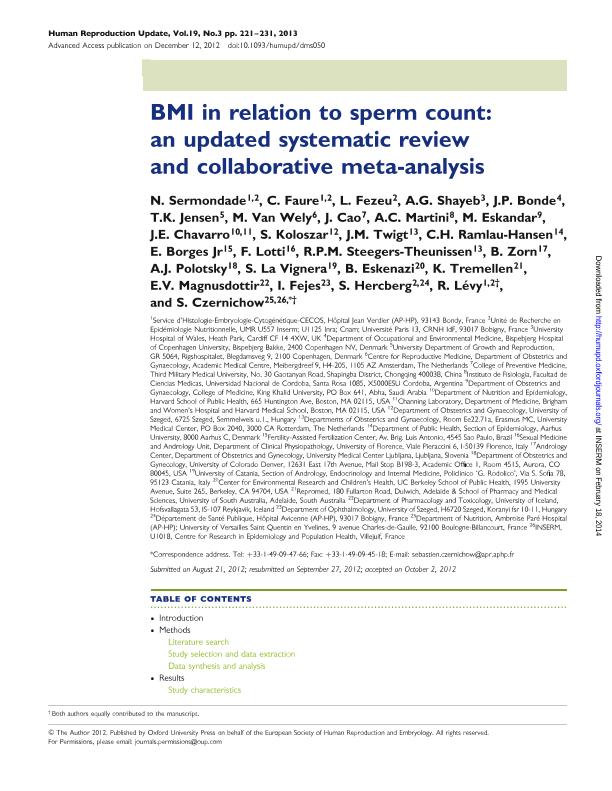Artículo
BMI in relation to sperm count: an updated systematic review and collaborative meta-analysis
Sermondade, N.; Faure, C.; Fezeu, L.; Shayeb, A. G.; Bonde, J. P.; Jensen, J. K.; Van Wely, M.; Cao, J.; Martini, Ana Carolina ; Eskandar, M.; Chavarro, J. E.; Koloszar, S.; Twigt, J. M.; Ramlau Hansen, C. H.; Borges Jr, E.; Lotti, F.; Steegers Theunissen, R. P. M.; Zorn, B.; Polotsky, A. J.; La Vignera, S.; Eskenazi, B.; Tremellen, K.; Magnusdottir, E. V.; Fejes, I.; Hercberg, S.; Lévy, R.; Czernichow, S.
; Eskandar, M.; Chavarro, J. E.; Koloszar, S.; Twigt, J. M.; Ramlau Hansen, C. H.; Borges Jr, E.; Lotti, F.; Steegers Theunissen, R. P. M.; Zorn, B.; Polotsky, A. J.; La Vignera, S.; Eskenazi, B.; Tremellen, K.; Magnusdottir, E. V.; Fejes, I.; Hercberg, S.; Lévy, R.; Czernichow, S.
 ; Eskandar, M.; Chavarro, J. E.; Koloszar, S.; Twigt, J. M.; Ramlau Hansen, C. H.; Borges Jr, E.; Lotti, F.; Steegers Theunissen, R. P. M.; Zorn, B.; Polotsky, A. J.; La Vignera, S.; Eskenazi, B.; Tremellen, K.; Magnusdottir, E. V.; Fejes, I.; Hercberg, S.; Lévy, R.; Czernichow, S.
; Eskandar, M.; Chavarro, J. E.; Koloszar, S.; Twigt, J. M.; Ramlau Hansen, C. H.; Borges Jr, E.; Lotti, F.; Steegers Theunissen, R. P. M.; Zorn, B.; Polotsky, A. J.; La Vignera, S.; Eskenazi, B.; Tremellen, K.; Magnusdottir, E. V.; Fejes, I.; Hercberg, S.; Lévy, R.; Czernichow, S.
Fecha de publicación:
05/2013
Editorial:
Oxford University Press
Revista:
Human Reproduction Update.
ISSN:
1355-4786
e-ISSN:
1460-2369
Idioma:
Inglés
Tipo de recurso:
Artículo publicado
Clasificación temática:
Resumen
Background: The global obesity epidemic has paralleled a decrease in semen quality. Yet, the association between obesity and sperm parameters remains controversial. The purpose of this report was to update the evidence on the association between BMI and sperm count through a systematic review with meta-analysis.
Methods: A systematic review of available literature (with no language restriction) was performed to investigate the impact of BMI on sperm count. Relevant studies published until June 2012 were identified from a Pubmed and EMBASE search. We also included unpublished data (n ¼ 717 men) obtained from the Infertility Center of Bondy, France. Abstracts of relevant articles were examined and studies that could be included in this review were retrieved. Authors of relevant studies for the meta-analysis were contacted by email and asked to provide standardized data.
Results: A total of 21 studies were included in the meta-analysis, resulting in a sample of 13 077 men from the general population and attending fertility clinics. Data were stratified according to the total sperm count as normozoospermia, oligozoospermia and azoospermia. Standardized weighted mean differences in sperm concentration did not differ significantly across BMI categories. There was a J-shaped relationship between BMI categories and risk of oligozoospermia or azoospermia. Compared with men of normal weight, the odds ratio (95% confidence interval) for oligozoospermia or azoospermia was 1.15 (0.93–1.43) for underweight, 1.11 (1.01–1.21) for overweight, 1.28 (1.06– 1.55) for obese and 2.04 (1.59–2.62) for morbidly obese men.
Conclusions: Overweight and obesity were associated with an increased prevalence of azoospermia or oligozoospermia. The main limitation of this report is that studied populations varied, with men recruited from both the general population and infertile couples. Whether weight normalization could improve sperm parameters should be evaluated further.
Palabras clave:
Obesity
,
Bmi
,
Sperm Concentration
,
Total Sperm Count
,
Meta-Analysis
Archivos asociados
Licencia
Identificadores
Colecciones
Articulos(INICSA)
Articulos de INSTITUTO DE INVESTIGACIONES EN CIENCIAS DE LA SALUD
Articulos de INSTITUTO DE INVESTIGACIONES EN CIENCIAS DE LA SALUD
Citación
Sermondade, N.; Faure, C.; Fezeu, L.; Shayeb, A. G.; Bonde, J. P.; et al.; BMI in relation to sperm count: an updated systematic review and collaborative meta-analysis; Oxford University Press; Human Reproduction Update.; 19; 3; 5-2013; 221-231
Compartir
Altmétricas



